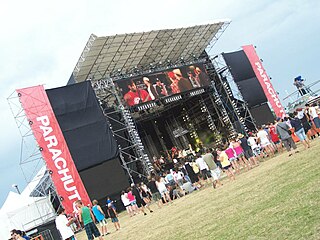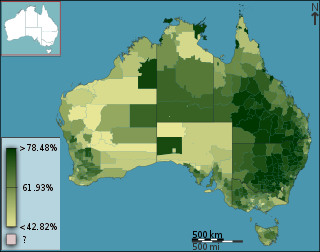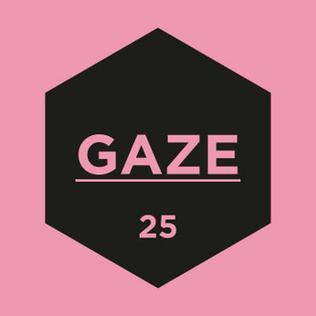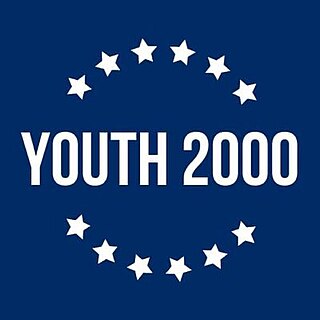
Peel is a seaside town and small fishing port in the Isle of Man, in the historic parish of German but administered separately. Peel is the third largest town in the island after Douglas and Ramsey but the fourth largest settlement, as Onchan has the second largest population but is classified as a village.

Coalisland is a small town in County Tyrone, Northern Ireland, with a population of 5,682 in the 2011 Census. Four miles from Lough Neagh, it was formerly a centre for coal mining.

Fuengirola is a city on the Costa del Sol in the province of Málaga in the autonomous community of Andalusia in southern Spain. It is located on the central coast of the province and integrated into the region of the Costa del Sol and the Commonwealth of Municipalities of the Costa del Sol Occidental.

The Ashton Court Festival was an outdoor music festival held annually in mid-July on the grounds of Ashton Court, just outside Bristol, England. The festival was a weekend event which featured a variety of local bands and national headliners. Mainly aimed at local residents, the festival did not have overnight camping facilities and was financed by donations and benefit gigs.

The Centre for Talented Youth Ireland (CTYI) is a programme for students of high academic ability between the ages of six and seventeen in Ireland.
The Queer Youth Network (QYN) was a national non-profit-making organisation that was run by and for lesbian, gay, bisexual and transgender (LGBT) young people and is based in the United Kingdom. It had an aim to represent the needs and views of younger LGBT people by campaigning for greater visibility and equal rights, as well as providing general support and information to those who are just coming out or who are experiencing homophobia.
Terence Christian is an English broadcaster, journalist and author. He has presented several national television series in the UK including Channel 4's late-night entertainment show The Word (1990–1995) and six series of ITV1 moral issues talk show It's My Life (2003–2008). He has also been a regular guest panelist on the topical Channel 5 series The Wright Stuff and Jeremy Vine.

Parachute Music Festival was a Christian music festival held annually in New Zealand between 1992 - 2014. Originally starting in Waikanae, the event moved to Matamata in 1995, and then finally to Mystery Creek Events Centre, Hamilton, New Zealand where it was held from 2004 - 2014. The three-day festival was run by Parachute Music, and ran annually in late January, on the weekend before Auckland Anniversary Day. The event was one of the largest Christian music festivals outside of the United States and it was one of the largest multi-day festivals in the Southern Hemisphere. As well as musicians, it also featured guest speakers.

Nottingham Playhouse is a theatre in Nottingham, Nottinghamshire, England. It was first established as a repertory theatre in 1948 when it operated from a former cinema in Goldsmith Street. Directors during this period included Val May and Frank Dunlop. The current building opened in 1963.

Glenarm is a village in County Antrim, Northern Ireland. It lies on the North Channel coast north of the town of Larne and the village of Ballygalley, and south of the village of Carnlough. It is situated in the civil parish of Tickmacrevan and the historic barony of Glenarm Lower. It is part of Mid and East Antrim Borough Council and had a population of 568 people in the 2011 Census. Glenarm takes its name from the glen in which it lies, the southernmost of the nine Glens of Antrim.

Christianity is the largest religion in Australia, with a total of 43.9% of the nation-wide population identifying with a Christian denomination in the 2021 census. The first presence of Christianity in Australia began with British colonisation in what came to be known as New South Wales in 1788.

Venture Scouts in Scouting Ireland are aged between 15 and 17 years of age. The awards scheme of Venture Scouts is called Rogha, an Irish word meaning Choice. Although many groups use Gaisce, the President's Award, as part of their programme also. Each group has a Venture Scout Executive which, under the guidance of an adult Scouter, designs and implements activities.

Glenarm Castle, Glenarm, County Antrim, Northern Ireland, is the ancestral home of the Earl of Antrim.

Youth Olympic Games is an international multi-sport event for athletes aged 15 to 18 years old. Organized by the International Olympic Committee, the Games are held every four years in staggered summer and winter events consistent with the current Olympic Games format, though in reverse order with the Olympic Winter Games held in leap years instead of the Games of the Olympiad. The first summer version was held in Singapore from 14 to 26 August 2010 while the first winter version was held in Austria from 13 to 22 January 2012.

Harold Creeth Miller is a retired Irish Anglican bishop. He served as bishop of the Diocese of Down and Dromore in the Church of Ireland. Coming from a Methodist background, he was elected bishop in 1997 and was considered to represent an evangelical position within the Church.

World Youth Day 2011 was the 2011 occurrence of World Youth Day, a Catholic event held from 16–21 August 2011 in Madrid, Spain focused on youth. Media estimated the event's attendance as over a million or 1.5 million.
City Montessori School, Kanpur Road Branch is a private school that offers education up to the intermediate level, in Lucknow, India. It is a co-educational, English Medium institution affiliated to ICSE Board, New Delhi. The streams offered are Science, Commerce and Arts. The school has been ranked 6th in the "most respected secondary schools" in India list compiled by IMRB in 2007.School has strength of 8397students with Pre-Primary as 1120, Primary as 3398, Junior as 1941 and Senior 1938.

A Christian music festival is a music festival held by the Christian community, in support of performers of Christian music. The festivals are characterized by more than just music; many feature motivational speakers and evangelists, and include seminars on Christian spiritual and missions topics, service, and evangelism. They are often viewed as evangelical tools, and small festivals can draw 10 times the crowd of traditional revival meetings. While the central theme of a Christian festival is Jesus Christ, the core appeal of a Christian music festival remains the artists and their music. Critics point out that the dichotomy of business and religious interests can be problematic for Christian festivals. In similar ways as the Christian music industry in general, festivals can be drawn away from their central theme and gravitate toward commercialization and mainstream acts in an attempt to draw crowds.

The GAZE International LGBT Film Festival Dublin is an annual film festival which takes place in Dublin, Ireland each Bank Holiday weekend in late July and early August. Founded in 1992, it has become Ireland's largest LGBT film event, and the country's biggest LGBT gathering aside from Dublin Pride.

Youth 2000 is an international Catholic movement for young people, generally between the ages of 16 and 35. Youth 2000's activities generally include the running of both community prayer groups and weekend retreats for young people. At their retreats, which are between two and five days long, teens and adults alike share their love for Jesus through the Eucharist, adoration, and praise and worship. It has been active since 1990 in the UK and in Ireland in 1993. The first weekly prayer group was held at the Carmelite Priory in Kensington.
















